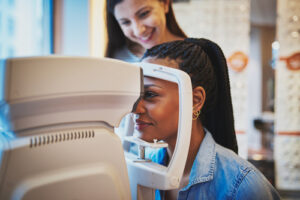Blog post by: Eye Physicians of Long Beach

Many eye problems, including those that cause permanent blindness, have no early symptoms. That’s why it’s integral to schedule a comprehensive eye exam regularly, even if you believe your eyes are healthy.
Seeing your eye doctor regularly for comprehensive eye exams helps ensure early diagnosis of eye conditions and protects your vision and eye health. Keep reading to learn more about the importance of annual eye exams with your ophthalmologist.
How Often Should You Have an Eye Exam?
For many patients, the answer to this question depends on many factors. These factors may include the following:
- Your age
- Personal and family medical history
- An existing eye condition
- If you wear prescription eyeglasses or contact lenses

The American Academy of Ophthalmology (AAO) suggests the following eye exam schedule for children and adults of different ages.
Children

Children might not know they have a vision problem. They may squint, tilt their head to see better, or rub their eyes more, all in an attempt to improve their vision.
Many issues with their vision may go unfound without regular eye exams with an eye doctor. By bringing them in for eye exams, an ophthalmologist can ensure that any vision problems are diagnosed and receive prompt treatment when it’s most likely to be effective.
Newborns
Before leaving the hospital, a pediatrician should check your infant’s eyes for defects, infections, glaucoma, and cataracts. However, newborns will need a comprehensive eye exam done by an ophthalmologist if they’re:
- Born premature
- Have signs of eye disease
- Have a family history of childhood eye disease
6 to 12 Months

Between 6 and 12 months, your pediatrician will check your child’s vision development, eye movement, alignment, and general eye health.
1 to 3 Years
Your pediatrician may perform a photoscreening test to check how well your baby can see. The test can help identify conditions such as a lazy eye.
3 to 5 Years

An optometrist or ophthalmologist should check your child’s eyes for abnormalities that might cause issues with later development. Once your child can read an eye chart, you should have their visual acuity tested.
If your child struggles reading an eye chart, you can also have a photoscreening done to check their vision.
A photoscreening can show signs of:
- Lazy eye
- Misaligned eyes
- Farsightedness, nearsightedness, or astigmatism
It’s essential to treat any of these eye issues without delay to protect your child’s vision and improve their quality of life.
5 Years and Older
Once your child is five or older, they need an eye alignment and visual acuity screening. A pediatric ophthalmologist should examine your child to see if they have problems such as a lazy eye.
No matter how old your children are, also be on the lookout for signs that could indicate they have a visual problem, such as:
- Persistent eye rubbing
- Sensitivity to light
- Red, watery, or itchy eyes
- Squinting
- Blinking excessively
- Holding objects too close
- A lack of concentration
- Irritability
- Avoiding the TV or books
- One eye that strays to one side
- Closing or covering one eye
- Tilting the head to the side
- Complaints of fatigue or headaches
If your child has any of these signs, visit your ophthalmologist. Children need regular vision screening through eye exams to prevent developmental and learning delays.
In some instances, your child may need a comprehensive eye examination if:
- A pediatrician refers you
- They have failed a vision screening
- You’ve noticed unusual signs as outlined above
- A vision screening can’t be done or is inconclusive
- Your child has developmental delays or a learning disability
Adults

Routine eye exams are essential in maintaining your vision and keeping your eyes healthy. Without regular eye exams, you may not receive a diagnosis for serious eye conditions until they’ve already caused irreversible vision loss.
The AAO recommends that adults with healthy eyes should have a comprehensive eye exam with an ophthalmologist once in their twenties and twice in their thirties. However, you may need to see your eye doctor more often if you:
- Have a family history of eye disease
- Wear eyeglasses or contact lenses due to refractive errors
- Have eye pain, injury, or infection
- Notice sudden flashes or floaters
- Previously had eye surgery or an eye injury
- Have certain conditions like diabetes, high blood pressure, and autoimmune disorders
- Are taking medications known to cause eye problems
You need a complete eye exam at age 40. Many people begin exhibiting early signs of eye conditions at this time, as well as changes to their vision.
Diagnosing and treating eye conditions promptly can protect your sight and prevent vision loss. After your examination, your ophthalmologist will tell you how frequently you should get your eyes checked.
It’s critical to follow the recommended schedule from your eye doctor because your risk of developing certain eye conditions increases as you age.
Seniors

For seniors 65 and older, regular eye exams are a must. Eye doctors recommend seniors schedule eye exams every year or two to keep their eyes healthy.
Your ophthalmologist will look for signs of age-related eye conditions like:
- Diabetic retinopathy
- Cataracts
- Glaucoma
- Age-related macular degeneration
Patients with age-related eye conditions will need to see their ophthalmologist more frequently. Your eye doctor will let you know how often you need to schedule follow-up appointments to ensure you do not lose your remaining vision.

Preserve Your Sight
Annual eye exams at Eye Physicians of Long Beach help protect your eyes and vision. They ensure that your prescription is up-to-date and that you receive an early diagnosis and prompt treatment if you have any eye conditions.
Want to enjoy a lifetime of healthy eyes and vision? It starts when you make your eyesight a priority. Schedule an appointment at Eye Physicians of Long Beach in Long Beach, CA, now!
